Cluedo & Clue Advanced Boardgames
Clue: The Great Museum Caper:
 There is a three
dimensional game board that represents a museum. There are six main rooms
(corresponding to a colour - one for each token... though that's just a
formality). Also, there is a "Power" (as in utility) room and another side
room as well as halls connecting the rooms. Each room and some hall entrances
have windows or doors which are randomly assigned locks which (when turned
over) will reveal if the door/window is locked or not. Okay... here's
what happens. One or more players take up the clue suspect tokens and place
them anywhere on the board. They then place little paintings around
the museum as well as security camera tokens. The player who plays
the thief does not play on the board, but rather plays on a little "blueprint"
of the museum behind a little shield so he can't be seen. The thief then
enters the museum and tries to steal paintings. (Remember, there is no
representation of him on the board since he's working on the blueprint).
There is a three
dimensional game board that represents a museum. There are six main rooms
(corresponding to a colour - one for each token... though that's just a
formality). Also, there is a "Power" (as in utility) room and another side
room as well as halls connecting the rooms. Each room and some hall entrances
have windows or doors which are randomly assigned locks which (when turned
over) will reveal if the door/window is locked or not. Okay... here's
what happens. One or more players take up the clue suspect tokens and place
them anywhere on the board. They then place little paintings around
the museum as well as security camera tokens. The player who plays
the thief does not play on the board, but rather plays on a little "blueprint"
of the museum behind a little shield so he can't be seen. The thief then
enters the museum and tries to steal paintings. (Remember, there is no
representation of him on the board since he's working on the blueprint).
The goal of the others is to find and capture him. The do this by tracking when paintings get stolen and using devices such as the security cameras. The thief can leave at any time to end the game, but usually continues until he is "seen". Once seen, he puts his gray token on the board and proceeds to finish the game from the board in full sight of the other players. The goal of the thief is to steal as many paintings as possible and escape through a door or window - first checking to see if it is unlocked. If it is locked, he has to go to another one - all the while being chased by the other suspects. Once that round is over, the players switch roles and see who can steal more paintings...
Text by : Michael Akers
This is a game with a 3-D board and play is much like the classic Cluedo
play. The biggest difference is that there are no murders and one of the
players is an invisible robber. The robber is never shown on the board
unless someone actually spots the robber. The robber moves on a note pad.
Players know what room he is in when the robber takes one of the paintings
(all being classic works of art). The players can also spot the robber
with motion detectors and surveillance cameras, unless he turns the power
to these off. The object here is to catch a thief.
Text by : Timothy
First of all, the game is out of print. The game is a 3-dimensional
art museum, and the pawns are the regular characters from the game Clue.
The object is to roll the dice, (there are no cards), and try to follow
the thief around the museum, and catch him, before he steals 3 paintings,
and escapes through an unlocked door or window. This game is really
fun, and I highly recommend that this game be played with a lot of
people. The more people the better!
Text by: Kirsty
Mr. Boddy (or Dr. Black over in UK) has just acquired new painting which
he will put in his museum. There is a thief whom one player is. The other
guests try to catch the thief. If the thief gets out of the museum with
3 paintings, he (or she) wins. There is one catch. You can't see the thief!!
The thief has his (or her) own pad of paper. Before the game, he (or she)
makes an overhead plan of the museum, placing cameras and paintings on
his (or her) sheet. If a suspect lands on the thief's spot when the thief
is invisible, that suspect wins. Same goes for when he is visible.
Text by: Kevin Eberle
Clue: The Great Museum Caper Rules
Super Cluedo Challenge:
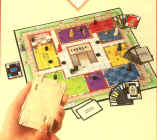 The first "altered"
spin off from the original game, this was bigger and flashier; but very
complicated to explain, so I apologise in advance.
The first "altered"
spin off from the original game, this was bigger and flashier; but very
complicated to explain, so I apologise in advance.
There are now nine people (Miss Peach, Captain Brown and Mr. Slate-Grey added), nine weapons (Poison, Blunderbus and Axe added) as well as the original nine rooms. Each card had a two colour and two number code in their four corners and the murder cards were placed in three special plastic holders, with "pull-back" covers/flaps to reveal one piece of the card's code.
Each player had a wipe-clean notepad, with each card's code inside so that you could work out what the murder cards were by revealing parts of the code throughout the game.
Instead of remaining murder cards being dealt at the start of the game, cards were picked up through the game by landing on a blue counter. These blue counters had a number on them between 1 and 50 which correlated to an instruction on the front of the players' notepad. This may say something like "draw a murder card" or "there is a clue on the bird table" ( I forgot to mention, there is now a "walkway" around the outside of the house, where the players start, and where there are four ornaments: a bird table, an urn, an orb and a sundial) - in the case of the latter, players must all rush to the bird table and the first person there gets to pick up a clue card.
A clue card is a card that says something like "draw three murder cards" or "you may look under two flaps".
Other changes are that there is now very little corridor between the rooms and every room contains a secret passage that can lead to any other room in the house.
This may be a very complex version of the game, but once you got the hang of it, it was fun to play. It also had a few aesthetic pluses - the board, the notepads and the cards were very "1920's" act deco style. This was the first version to have "portraits" of the suspects (like those in the Cluedo Murder Mysteries) rather than counters with heads (though we do miss those cards) and best of all, the playing pieces were plastic busts of the suspects in there own colours - very classy.
Cluedo Master Detective:
 This version of the
board game was never released in Britain (as far as I know) - except as
a computer game. I managed to track down a version in Paris though, hence
why the picture on the right says "Super Cluedo". This is very similar to the original
game, but with 10 suspects, 8 weapons and 12 rooms. These are the same
as before but with Sergeant Gray, Madame Rose, Monsieur Brunette and Miss
This version of the
board game was never released in Britain (as far as I know) - except as
a computer game. I managed to track down a version in Paris though, hence
why the picture on the right says "Super Cluedo". This is very similar to the original
game, but with 10 suspects, 8 weapons and 12 rooms. These are the same
as before but with Sergeant Gray, Madame Rose, Monsieur Brunette and Miss
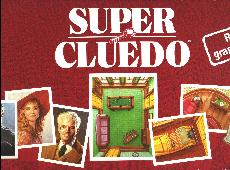 Peach; Poison and Horseshoe; Courtyard, Gazebo, Drawing Room, Carriage
House, Trophy Room, Studio and Fountain - but no Lounge, Study, Hall or
Ball Room. One other thing to change is that there are "Sleuth" squares
(marked with a magnifying glass) that when landed upon, the player may
pick a card at random from an opponent's hand to look at.
Peach; Poison and Horseshoe; Courtyard, Gazebo, Drawing Room, Carriage
House, Trophy Room, Studio and Fountain - but no Lounge, Study, Hall or
Ball Room. One other thing to change is that there are "Sleuth" squares
(marked with a magnifying glass) that when landed upon, the player may
pick a card at random from an opponent's hand to look at.
 HOT NEWS (9-Dec-01): A new version of
Master Detective (aka. Super Cluedo) has just been released in France,
with a new look similar in style to Cluedo Passport To Murder.
Hopefully, like that game, this one will also come over to Britain shortly!
HOT NEWS (9-Dec-01): A new version of
Master Detective (aka. Super Cluedo) has just been released in France,
with a new look similar in style to Cluedo Passport To Murder.
Hopefully, like that game, this one will also come over to Britain shortly!
For details of this version, go to the Master Detective 2001 page.
Thanks to Jérôme Viot for this latest information!
Cluedo Super Sleuth
 Basically, there
are 12 room tiles (normal nine plus Main Entrance, Cellar and Drawing Room).
You place the main entrance tile down and start there; then place more
rooms down (at random) as you enter them.
Basically, there
are 12 room tiles (normal nine plus Main Entrance, Cellar and Drawing Room).
You place the main entrance tile down and start there; then place more
rooms down (at random) as you enter them.
In each room, you have Clue Squares ( where you draw a clue card - i.e.. the normal, non murder cards ) and Item Squares, where you find things like a pair of gloves, a handkerchief, a cup of coffee etc. which help you in the game, like throwing 2 dice instead of one for a turn, or making a suggestion to any other player, drawing a clue card etc.
As well as this, the dice have a red spot on 2 sides - which means an event occurs. This may be moving to the room that hogarth is in (there are 3 non player characters by the way, Hogarth the Butler, Inspector grey, and The Black Dog ) or moving the Dog into play etc.
Another major part of play, is the fact that you don't make suggestions when you enter a room as per normal. Instead, you can only make a suggestion to a player who is in a room that you enter (you may say any room in your suggestion) - this usually leads to players going round, collecting clue cards, then once they have all been collected, chasing each other around the board, blocking people from leaving rooms ( you may only pass through another player if they give you permission, or you stay where you are for a turn; and you cannot move through a non player character ) so that you can run back in and ask them another suggestion.
All this leads to more tactical playing than the original game (as you have most of the original deduction tactics and then the new ones on top).
This makes this game DEFINITELY the best in the series.
Cluedo Passport To Murder:
 Released at the end of 2000, this is a very classy
advanced version which is basically a new release of "Super Cluedo Challenge" but this time set in a railway station.
The only downside with this version is that it has the crumby plastic character pieces that the current UK original version has (though holding suitcases
and wearing coats etc.) which are a bit of a disappointment after the busts of Super Cluedo Challenge.
Released at the end of 2000, this is a very classy
advanced version which is basically a new release of "Super Cluedo Challenge" but this time set in a railway station.
The only downside with this version is that it has the crumby plastic character pieces that the current UK original version has (though holding suitcases
and wearing coats etc.) which are a bit of a disappointment after the busts of Super Cluedo Challenge.For more details, see the Passport To Murder section.
Cluedo SFX / Clue FX / Super Cluedo Ineractif:

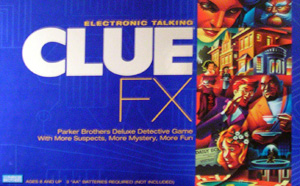 Released in autumn 2003 in the US,
July 2004 in the UK and November 2004 in France,
this novel addition uses electronic recordings to take the players through the mystery and move them around the board.
Released in autumn 2003 in the US,
July 2004 in the UK and November 2004 in France,
this novel addition uses electronic recordings to take the players through the mystery and move them around the board.The game can be purchased from Amazon.com / Toys R Us or Amazon.co.uk.
Below is Raymond Smith's review of the game. More pictures and information can be found at "The Art of Murder".
"The game retails for about $30 (I'm sure it's less at Target or Walmart). 'Ages 8 and up - Two to Four Players - Three 'AA' Batteries required (not included) - Assembly required'
 Released in autumn 2003, "The artwork is done in the same style as the latest version of Clue; however the game board is a more stylized country estate rather than a true representation. When unfolding the board for the first time, it reminded me of 'The Game of Life'. There is a cardboard backdrop of 'Tudor Mansion' that covers the electronic base (the voice box which replaces the die/dice) Though the backdrop is attractive, I have always found such gimmicks as a waste of time; I would have preferred the 'voice box' to be molded in the shape of the Boddy home. The program controls are disguised as shrubbery and the on/off switch in on the back of the base. With nitpicking aside, the board is beautiful.
Released in autumn 2003, "The artwork is done in the same style as the latest version of Clue; however the game board is a more stylized country estate rather than a true representation. When unfolding the board for the first time, it reminded me of 'The Game of Life'. There is a cardboard backdrop of 'Tudor Mansion' that covers the electronic base (the voice box which replaces the die/dice) Though the backdrop is attractive, I have always found such gimmicks as a waste of time; I would have preferred the 'voice box' to be molded in the shape of the Boddy home. The program controls are disguised as shrubbery and the on/off switch in on the back of the base. With nitpicking aside, the board is beautiful.
 "Set up is more or less the same as Cluedo/Clue. The locations are now the garage, the garden, the gazebo, the tennis court, the swimming pool, the gate house, the stables, the boathouse and the mansion. The new weapons are the dangerous-looking hammer and garden shears, the impractical horse shoe and bucket, and the whimsical tennis racket and garden gnome.
"Set up is more or less the same as Cluedo/Clue. The locations are now the garage, the garden, the gazebo, the tennis court, the swimming pool, the gate house, the stables, the boathouse and the mansion. The new weapons are the dangerous-looking hammer and garden shears, the impractical horse shoe and bucket, and the whimsical tennis racket and garden gnome.
 "The original six suspects are here, along with two more: Rusty the gardener (represented by a reddish brown color) and Mrs. Meadow-Brook (teal). The new 'victim of foul play' is John Boddy's attorney, Miles Meadow-Brook. But the characters don't end there! The narrator of the event is Mr. Boddy's butler, Mr. Ashe, and the 'finish line' is Inspector Brown. Now in this version, you do not play as one of the eight suspects, but you assistant one of the FOUR amateur sleuths: Prince Azure, Lady Lavender, Lord Gray, and the familiar, but completely innocent, Miss Peach.
"The original six suspects are here, along with two more: Rusty the gardener (represented by a reddish brown color) and Mrs. Meadow-Brook (teal). The new 'victim of foul play' is John Boddy's attorney, Miles Meadow-Brook. But the characters don't end there! The narrator of the event is Mr. Boddy's butler, Mr. Ashe, and the 'finish line' is Inspector Brown. Now in this version, you do not play as one of the eight suspects, but you assistant one of the FOUR amateur sleuths: Prince Azure, Lady Lavender, Lord Gray, and the familiar, but completely innocent, Miss Peach.
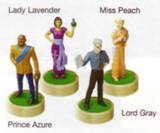 "After picking the weapon, location, and murderer cards and filing them away and shuffling the remaining cards, you now give each one of the eight SUSPECTS a card; each suspects have their own envelope (with their picture and color on it) and then each sleuth is dealt the remaining cards.
"After picking the weapon, location, and murderer cards and filing them away and shuffling the remaining cards, you now give each one of the eight SUSPECTS a card; each suspects have their own envelope (with their picture and color on it) and then each sleuth is dealt the remaining cards.
"Then you log your sleuth into the game. After you log in, Mr. Ashe welcomes you to Tudor Mansion and then the butler announces who moves first. This is the first really nifty change from the original: NO DIE/DICE and NO CORRIDORS! Like the card game, you jump from one location to another. Mr. Ashe announces who's to move! This is the second terrific change in that if you are playing a three or four player game, the next player to move is random! Everyone gets to move once during a round, but it's anybody's guess who will be told to move next. (In a two player game, the players just alternate turns.)
"On your move you: 1) Move, 2) Make suggestion or 'Search' 3) Make a final accusation.
"You may make a traditional suggestion at which point the person to your left tries to disprove. However if you choose to 'Search', you may search and interrogate the suspects in a location. This simply means you get to look in his, her, or their envelope(s). When you are through with your turn, you press the shrub marked 'Done' and Mr. Ashe announces the next player to move.
"At some point, early in the game, Inspector Brown arrives (with a melodramatic flourish); at this point, if you are ready to, you may locate Inspector Brown and make your final accusation.
"This is a much simplified description of actual game play. Throughout the game, it is announced that suspects have left their last location and moved to a new one; some of the suspects are actually hiding in locations and you must 'search' for them. When Inspector Brown appears, it is announced that he has gone to one of the nine locations and he moves from place to place throughout. Sound effects are also used as clues. All of the characters greet you as you encounter them. The game is familiar, but fresh at the same time. It's great!"
Clue Mysteries:

 Released in the US in April 2005 and Europe in Summer 2006, this game is a cross between Clue and the 80s boardgame: "The Mysteries Of Old Peking". Head over to Amazon.com or Amazon.co.uk for a copy.
Released in the US in April 2005 and Europe in Summer 2006, this game is a cross between Clue and the 80s boardgame: "The Mysteries Of Old Peking". Head over to Amazon.com or Amazon.co.uk for a copy.
Here's a wealth of information from Simon Laflamme about the American edition (see below for British information):
FACTS:
- The game takes place in the town of Hampshire in the summer of 1925.
- It presents itself as a prequel to the 2002 US version of the game, as well as Clue FX.
- All six usual suspects join a 29-year old John Boddy, his uncle Sir Hugh Black, the 5 new suspects of Clue FX (Rusty Nayler, Prince Azure, Lord Gray, Lady Lavender and Mrs. Meadow-Brook), plus Ms. Peach (who had previously appeared in Master Detective and the VCR games), as pre-eminent citizens of Hampshire.
- Inspector Brown is identified as Hampshire Chief of Police.
- It is heavy on character backgrounds for hints on whodunit, relying on ideas thrown in the aforementioned editions, such as: Ms. Scarlet is Mrs. Peacock's daughter.
- Clue Mysteries marks the first time in America the character of Green is referred to as "Reverend Green".
- Only four of the six player pawns represent the usual suspects: Col. Mustard, Ms. Scarlet, Mrs. Peacock, and Reverend Green. A rusty-orange pawn seems to represent Rusty Nayler, and a sickly lavander-colored pawn is more reminiscent of Lady Lavender than Prof. Plum. No Mrs. White as a player character in this edition.
- The game is "uncannily" similar to "Mysteries of Old Peking" (MoOP). The board is identical, if Clue-themed, and the props are likewise identical, so seems to be the gameplay (Refer to Globetrotter Games for more info on the original game) except for witness cards which have been replaced by witness wheels - on which players decode the clues.
- The object of the game is to decipher enough witness statements to identify who the culprit is and confront him in the "scene" he is hiding in.
- The board features a starting point in the middle, the abodes of the six usual suspects (Scarlet Theatre, Mustard Lodge, White Cottage, Hampshire Church (Rev. Green, Vicar), Peacock Residence, and Prof. Plum's Castle) plus Tudor Mansion and the Police Station, linked by roads. Each of the main roads leading from the starting point features a "shortcut spot", from which you can go anywhere you please on the board.
- There are also "scene tokens", the Cart, the Fair, the Parade and the Bus, which players must circumvent or go to once they feel ready to make an accusation. (The culprit is always hiding in one of these)
- Players must race around the board, visiting the abodes of the six usual suspects; using a mirror, code key, or a transparent red plastic magnifying glass to decipher statements leading to the solution of one of the 50 mysteries contained in a quest book.
- Vital to cracking the case are visits to Tudor Mansion where Mr. Boddy reveals where the culprit is hiding, and the local police station where Inspector Brown tells the players which (if any) suspect is lying. (Boddy and Brown, in all likeliness take the place of the Spy and the Wise Man from MoOP.)
- Once a player feels ready to accuse, he must journey to the scene token he thinks the culprit is hiding in, and verify his accusation in the quest book.
- Clue Mystery cards, drawn when a player lands on an open road square, keep player pawns and scene tokens in frequent motion by bearing instructions to "Go directly to the Scarlet Theater", or "Move any one scene token to any open road space".
Gameplay is fast and addictive, but the simplicity of it makes one wonder if this should not be considered a "Junior" game rather than an advanced version of Clue (the fact that there are no murders in Clue Mysteries, mostly theft, support this). Although the fun of the game still resides in finding out whodunit, the game's accent on deciphering statements with ridiculous props, rather than deducing which cards are in the murder envelope or other players' hands, make this more of a race than an investigation in the Clue tradition.
The uncanny resemblance to MoOP also takes a lot from it, as the inspiration drawn from MoOp is more than just the concept. Despite similarities in idea, "The Great Museum Caper" stood alone, and apart from "Scotland Yard".
The graphic design of the game would also appeal to a younger audience, as the 1920s art-deco feel which revitalized the 2002 US Clue edition, here draws undoubtedly on the childish. One glance at Prof. Plum's purple take on the Disneyland Castle is enough to make any fan of the original game wince in pain.
Still, a palatable, if poor and forgettable outing in the Clue(do) series. [Review by Simon Laflamme]
 Cluedo Mysteries is set to hit Europe in September 2006. Click on the picture to the left for the UK cover and see Cluedopédie for information on the continetal European versions. The blurb for the British version is as follows:
Cluedo Mysteries is set to hit Europe in September 2006. Click on the picture to the left for the UK cover and see Cluedopédie for information on the continetal European versions. The blurb for the British version is as follows:
Set in the English summer of 1925, Dr. Black and his lawyer, Miles Meadow-Brook, are still alive. But twelve deceitful characters are plotting their demise and turning Hampshire into a hotbed of petty crimes! Inspector Brown’s casebook is bulging with unsolved mysteries and he needs your help to solve them. Choose one of the 50 mysteries, then travel from location to location to question witnesses and decode their clues. Use the red spyglass, secret mirror and location key to decipher the evidence. Remember to visit all witnesses, as Inspector Brown will tell you if anyone's lying and Dr. Black always knows where the guilt party is hiding. The first detective to discover "whodunnit" and where the culprit is wins the game! Contents - 1 gameboard, 6 movers, 6 detective notebooks, 1 pad of notebook sheets, 24 cards, 4 scene tokens, 8 character wheels with plastic buttons and stands, 1 spyglass, 1 secret mirror, 1 location key, 1 die, label sheet and instructions with casebook.
Cluedo DVD Game:


 In October 2005, the Cluedo DVD Game was released in the UK; shortly followed by a French edition. The image to the left is the released cover in the UK; the two images to the right are concept box covers.
In October 2005, the Cluedo DVD Game was released in the UK; shortly followed by a French edition. The image to the left is the released cover in the UK; the two images to the right are concept box covers.

 Clue DVD Game was finally released in the USA in April 2006 (images left and right).
Clue DVD Game was finally released in the USA in April 2006 (images left and right).
FACTS:
|
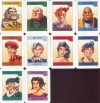 |
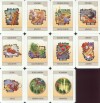 | |
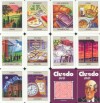 | |
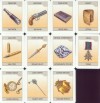 | |
 | |
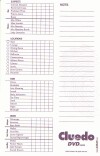 | |
 | |
 | |
 | |
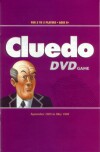  |
| Animations: | |||
 |
Opening Titles | 178 KB (Real Media) | |
 |
The Monte Carlo Affair | 390 KB (Real Media) | |
© Paul Howls, 1998-2005
Cluedo & Waddingtons are © Hasbro International Inc. Distributed in the UK. by Waddingtons Games, Castle Gate, Oulton, Leeds LS26 8HG